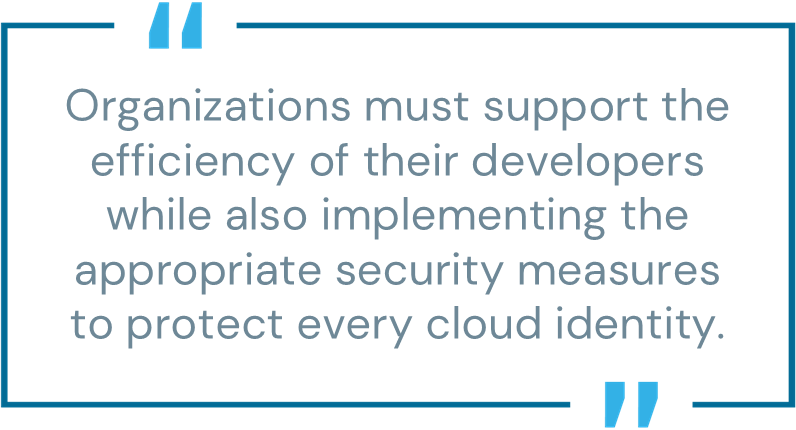
Developers are incredibly valuable to an organization’s progress and evolution. They must innovate quickly while simultaneously navigating changes to their day-to-day operations as companies heighten security requirements in the cloud.
If developers find these security measures cumbersome, creating hurdles that plague their progress, they will likely bypass them altogether. Implementing a robust cloud security strategy requires a delicate balance between safeguarding valuable assets and allowing for developer innovation as business needs evolve.
Threat actors recognized the vulnerability of cloud environments long ago, using this avenue to exploit inferior security measures and gain access to critical infrastructure. With most enterprises operating across multiple cloud environments, the threat landscape has grown exponentially and shows no sign of slowing.
The proliferation of human and machine identities has only increased business risk. Attackers are preying on unsuspecting identities that hold powerful standing access, such as service accounts or identity and access management (IAM) roles with access to privileged data. In response, organizations are implementing increasingly stringent security requirements in the cloud, which directly impacts the native user experience (UX) of developers.
Securing Developers Without Slowing Them Down
Organizations must support the efficiency of their developers while also implementing the appropriate security measures to protect every cloud identity. Digital transformation initiatives have only increased development velocity, making cloud access hurdles even more crippling to productivity.

Designing workflows that seamlessly combine security with access controls will prevent developers from circumventing authentication requirements and instead encourage the adoption of best practices. Securing the cloud with zero standing privileges (ZSP) can help to significantly reduce the risk of credential theft and lateral movement, as users receive just-in-time (JIT) entitlements with access limited to specific periods of time.
Creating a Developer-Friendly Security Environment
Organizations can create a developer-friendly security environment that marries access controls with ease of use to support innovation. By efficiently and intuitively securing cloud environments at every layer, organizations can gain the power to:
1. Achieve a Holistic View of Their Cloud Estate
The sprawl of identities and entitlements across the cloud environment can create a relentless fog for IT security teams. With a centralized view of the multi-cloud environment, security teams can assess each layer of their infrastructure from a single point of control and apply ZSP without hindering the UX of developers and other teams.
2. Customize Access Policies for Developers
Because of the quick nature of the role, developers cannot waste time waiting for access to critical cloud resources.
Organizations can secure the cloud without making their employees jump through hoops by creating roles and groups with unique access policies. Implement time-bound roles, session protection and automated entitlement removals for other users accessing cloud-based services like databases or SaaS applications. This practice minimizes the risk of malicious users navigating through the cloud.
On the other hand, developers frequently accessing cloud resources should not be roadblocked by access controls. Granular policy configurations can help give them the time, entitlements and approvals (TEA) needed to succeed. For efficiency, send necessary access requests directly to the approver using ChatOps tools like Slack or Teams.
With dynamic, break-glass access, developers can securely request or elevate access in critical situations like outages and other production emergencies.
3. Integrate Access Controls with Developer Tools
To increase adoption and support productivity, organizations can integrate elevated access requests with existing tools, such as service desks or ChatOps, to help secure cloud resources with minimal disruption. By embedding lightweight security into existing tools, automating approvals and securing developers in their native CLI workflows, developers will likely adopt best practices without resistance. Enable privileged access management (PAM) for developers by providing out-of-the-box (OOTB) integrations natively to deliver a familiar UX.
4. Maintain Compliance in the Cloud
With so many moving pieces across multi-cloud architectures, monitoring every layer and end user is crucial. Continuously monitoring and recording activity in the cloud offers protection for audits and future investigations.
Meanwhile, improved visibility of permissions and associated risks can help teams remove unnecessary entitlements and mitigate risk.
Balancing Cloud Security and Developer Productivity
Security teams consistently struggle to maintain a secure cloud environment while facilitating productivity. The pace of cloud innovation is not slowing down, and threat actors are only becoming savvier, adding to the pressure to provide cloud users with access while appropriately securing it.
Want to explore how easy implementing zero standing privileges can be? Get started with your free CyberArk Secure Cloud Access trial in minutes.
Brooke Jameson is a senior product marketing manager at CyberArk.























